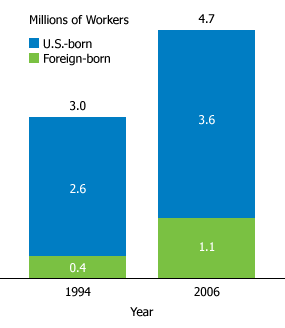Mary Kent
Consultant

January 11, 2011
Consultant
Scientists and engineers working in the United States are increasingly likely to be foreign-born, primarily because the United States continues to attract large numbers of skilled workers from abroad. In an article in the journal Demography, Vanderbilt University professor Mariano Sana reported that the ratio of foreign-born to U.S.-born scientists and engineers doubled in little more than a decade (see figure).1 In 1994, there were 6.2 U.S.-born workers for every foreign-born worker in science and engineering occupations. By 2006, the ratio was 3.1 to 1.
More than 60 percent of foreign-born scientists and engineers in the United States in 2009 were from Asia, according to Census Bureau data analyzed by PRB. Nearly one-fourth were from India, with another one-fifth from China, the Philippines, and Taiwan.
Foreign-born residents not only expanded the U.S. high-tech workforce but helped start new businesses that have generated billions in revenue and hired tens of thousands of workers. Foreign-born entrepreneurs helped start one-fourth of all new U.S. engineering and technology business established between 1995 and 2005, including Google and eBay. In high-tech Silicon Valley, California, more than one-half of business start-ups over that period involved a foreign-born scientist or engineer; one-fourth included an Indian or Chinese immigrant.2

Note: Includes workers with at least a bachelor’s degree.
Source: Mariano Sana, Demography 47, no. 3 (2010): table 1.
What caused this shift? Were fewer U.S.-born students going into the sciences and mathematics? Did the recent wave of immigrants include more scientists than previous waves? Did U.S. immigration policy change to attract more scientists and engineers? None of these factors had a major role in boosting the proportion of foreign-born workers in these occupations, according to Sana’s research. The heavy volume of immigrants, driven by ample job opportunities in science and engineering, explained about three-fourths of the increase.
The number of foreign scientists and engineers entering the United States has ebbed and flowed along with the job opportunities in those fields. U.S. immigration policy apparently did not have a large effect on these trends. Foreign professionals may enter the country and work for up to six years under an H-1B visa, and many U.S. firms used these visas to hire foreign scientists and engineers during the dot-com boom of the 1990s. High-tech firms twice persuaded the U.S. Congress to increase the annual limit on H-1B visas (originally 65,000) to allow in more foreigners.3 But Sana found that raising the visa ceiling did not raise the ratio of foreign-born to U.S.-born scientists and engineers. In fact, the number of visas awarded fell short of the new ceiling after the dot-com “bust” because of declining job opportunities. The ratio of foreigners to U.S.-born in these jobs declined slightly in the early 2000s, but has generally trended upward.
Many foreign-born scientists and engineers arrive with advanced degrees in their field, but the majority are products of U.S. graduate programs. The NSF reports that about two-thirds of foreign doctoral students stay in the United States at least five years after earning a degree from a U.S. university.
Foreign-born students are earning an increasing percentage of U.S. graduate science and engineering degrees. They earned 40 percent of U.S. doctoral degrees in science and engineering in 2003, and they were responsible for most of the growth in doctoral degrees in these fields between 1985 and 2005.4 Just four countries—China, India, South Korea, and Taiwan—accounted for one-half of the doctorates awarded to foreign-born students during that period.
The economic downturn appears to dampen the enthusiasm for coming to the United States to study and work. Enrollment of new graduate students in science and engineering dropped 2 percent between 2008 and 2009.5 Because science and engineering students make up nearly one-half of all foreign students in U.S. universities, this drop may also signal smaller increases—or even decreases—in overall foreign enrollment in the near future.
Some foreign professionals leave their U.S. jobs to work in their own or another country, although there are no solid estimates of how many are returning or whether the number is increasing.6 This return migration reflects economic recessions in the United States as well as expanding opportunities elsewhere. The economies of India, China, South Korea, and many other developing countries, for example, are growing more rapidly than the U.S. economy. Because immigrants from these countries are more likely to be highly educated, they often can take advantage of new opportunities back home or more lucrative jobs in other countries.
Regardless of how this plays out, the foreign-born presence in U.S. science and engineering jobs remains strong and the United States still attracts the best and brightest from many countries.
